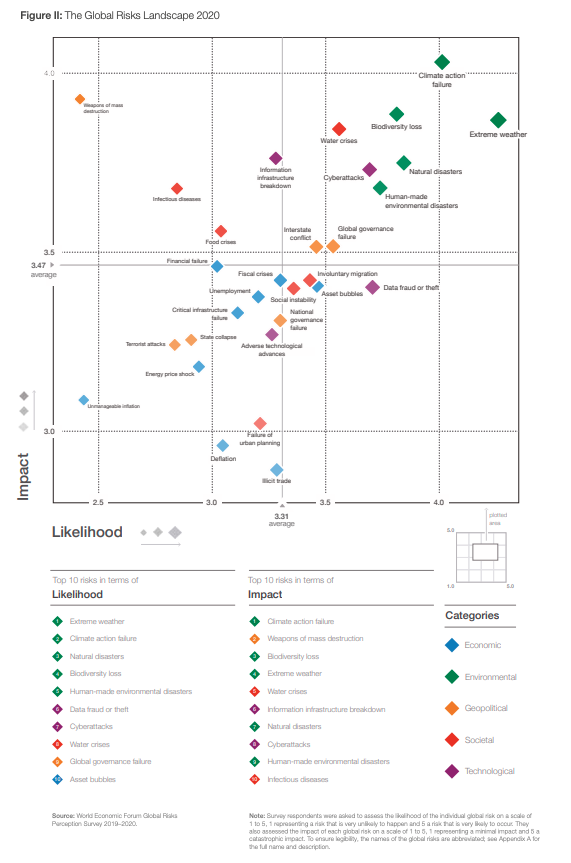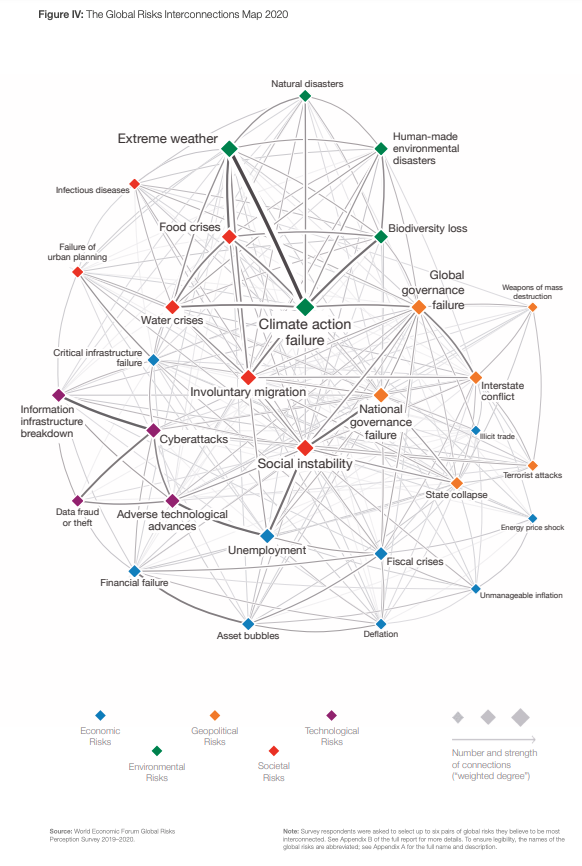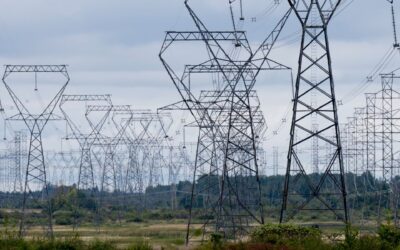COVID-19 Recovery series
As the country moves towards economic recovery from the pandemic, the Institute considers the policy choices ahead for Canada.
In the 2020 edition of the World Economic Forum’s Global Risks Report, infectious diseases did not appear near the top in their global risks perception survey (Figure 1). Reflecting on the enormous ongoing and impending impacts of the COVID-19 pandemic on lives, communities and economies, one might conclude that the relatively low prioritization of infectious disease risk was a major miscalculation. Yet a closer look at the WEF analysis reveals some deeper insights that are all too relevant.

Figure 1 – From The Global Risks Report 2020, World Economic Forum
The biggest threat come from multiple risks, interacting with each other
The WEF recognizes that risks do not occur in isolation but can be strongly interconnected. It asked their experts and stakeholders to identify how risks might influence and exacerbate one another. The resulting web of risk relationships (see Figure 2, below) is highly complex . Tracing the evolution of the current global crisis — from infectious disease to social instability and governance setbacks and onward to the realization of a variety of major economic risks — is not difficult in retrospect.

Figure 2 – From The Global Risks Report 2020, World Economic Forum
Figure 2 underscores that we live in a world of extreme complexity and interconnectedness. Information, people, energy, materials, goods and money are continuously exchanged and distributed on a global scale. Even though these interdependent systems are of our own making, they are now so complex that we no longer completely understand them and frequently don’t have effective control of them. As a result, they can become fragile, vulnerable and unpredictable in ways that we don’t recognize until it is too late.
The events that can trigger major system disruptions and failures are often surprising. The 2003 Northeast blackout, for example, started with tree branches touching power lines in Ohio but ultimately affected 55 million people in Canada and the U.S. The 2008 global financial crisis began with overextended households defaulting on subprime mortgages in the U.S. and culminated in a prolonged recession. In both cases, seemingly modest disturbances quickly propagated through tightly interconnected and brittle systems, creating a cascade of failures that led to catastrophe.
We very often don’t realize the weak points in our systems until some kind of failure actually occurs. Only in hindsight and with the benefit of forensic analysis can we understand that both the Northeast electrical grid and the financial excesses of the “noughties” decade were accidents waiting to happen.
The COVID-19 pandemic is similar. The world hoped that international and national health systems would prevent the spread of emerging new diseases. However, those systems were not prepared for the unique characteristics of the SARS-CoV-2 virus, nor for the pace with which today’s patterns of global trade, travel, and community interactions facilitated its rapid transmission worldwide. The shortcomings of global detection and prevention systems were quickly exposed, and the weaknesses of acute care systems and international medical products supply chains became abundantly clear very shortly thereafter.
Despite the COVID-19 pandemic’s unprecedented systemic impacts, it is a time-limited phenomenon and its acute effects will likely end sometime in the next year to two years. When the pandemic as a major source of disruption is gone, we can start to rebuild our social and economic systems and work towards getting back to the trajectory we were on a few months ago.
Climate change is different
Although we can still avoid the worst impacts of climate change by achieving dramatic emissions reductions, we are now locked in to decades, if not centuries, of continual global warming. This warming will generate ongoing shocks with acute and cumulative impacts equal to or potentially greater in scale and scope than the COVID-19 pandemic. Among other potentially catastrophic impacts, sea-level rise will cause trillions of dollars in damage to coastal nations, communities and infrastructure, hundreds of millions of people each year will become exposed to dangerous heat and humidity, and drought, desertification and erratic weather could lead to regular and food crises that are global in scale .
In Figure 2, we can see that the risk of global failure to act on climate change — which has already partially come to pass —- is strongly connected to social instability, food and water crises, governance failures and ultimately with all types of major economic risks. With a continuous stream of climate shocks queued up, any one of these climate change-induced threats — or a combination thereof — could strike at any time. Even worse, climate impacts and other risks might occur simultaneously and reinforce one another, such as the upcoming possibility of forest fires in Western Canada during the COVID-19 pandemic.
Under climate change, we may not have the luxury of addressing our systemic weaknesses one at a time. The frequency and scale of shocks and system failures is likely to overwhelm us first.
A resilient system addresses the source of vulnerability rather than the symptoms
Two approaches to managing risk and preparing for impacts can help us to get ahead of this challenge.
First, we need to better understand our complex, interconnected global systems and systemic risk. We can build on efforts such as those to understand systemic risk in global financial systems following recent crises and expand these to include other critical global systems — food, communications, health, energy, manufacturing, etc. — and their interconnections. This requires collaboration across academic disciplines, sectors, jurisdictions and international boundaries to map these systems, understand their vulnerabilities to climate change and other types of risks (which, let’s not forget, will also continue to occur), and learn how to recognize the precursors and early signs of system failure. Canada has been notably slow in assessing even basic climate risks and needs to accelerate progress and to build in the examination of interconnected risks and cascading effects.
Second, we need a whole-of-society approach effort to build systemic resilience. This means addressing the underlying causes of weakness and vulnerability in our systems, not just the symptoms. Doing so will make Canada more capable of absorbing all kinds of shocks and disturbances, not just the ones we have already lived through or those we can see coming, but those that are outside our scope of experience. For example, after the experience of the COVID-19 pandemic there will likely be major investment in respiratory disease monitoring and acute care systems which, although obviously important, will do little to help us prepare for hurricanes. Fighting poverty and marginalization, improving environmental quality and reducing pollution, protecting biodiversity, and re-localizing some production and supply chains are all interventions that would reduce the likelihood and severity of a future pandemic and increase our systemic resilience to climate shocks as well as many other risks.
As we rebuild from the COVID-19 pandemic, we need to understand the weaknesses and vulnerabilities of our social and economic systems and address their root causes by building systemic resilience. This is the only way we can we build our collective capacity to survive and thrive in an increasingly uncertain and unpredictable future dominated by climate change.
COVID-19 Recovery – More of this series





